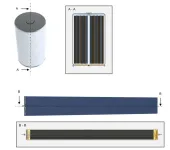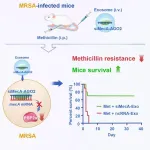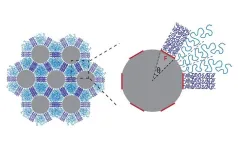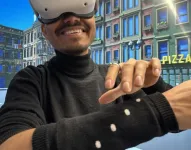(Press-News.org) (Boston)—More than 120 million Americans suffer from diabetes or pre-diabetes. Triple-negative breast cancer (TNBC) is the most aggressive form of breast cancer, and TNBC patients with obesity-driven diabetes often have worse outcomes.
A new study by researchers from Boston University Chobanian & Avedisian School of Medicine helps explain why this happens and suggests a potential way to improve treatment for these patients.
At present, oncologists do not consider patients with breast cancer and obesity-driven diabetes differently in any significant way from patients with breast cancer who are otherwise healthy.
The new study, "Insulin Resistance Increases TNBC Aggressiveness and Brain Metastasis via Adipocyte-derived Exosomes," published in Molecular Cancer Research, a journal of the American Association for Cancer Research, shows that diabetes changes the biology of breast cancer, suggesting the need for special consideration for patients who are at much higher risk for brain metastasis and should be monitored and treated differently than most breast cancer patients.
“We hope our study will lead to better treatments for patients with aggressive breast cancer, especially those with metabolic disorders like diabetes. By uncovering how cancer and metabolism are connected, we move one step closer to more personalized and effective therapies,” said corresponding author Gerald V. Denis, PhD, MSc, Shipley Prostate Cancer Research Professor and professor of pharmacology, physiology & biophysics.
Researchers collected exosomes from fat cells and studied how the microRNAs they contain worsen TNBC cell behavior. They then added these exosomes to cancer cells in lab experiments, and experimental models of breast cancer metastasis, and observed dangerous changes in their growth, movement, ability to survive under stress and colonize the brain. They found that microRNAs, which are involved in many biological processes, including cell differentiation and insulin secretion, are carried in the exosomes and promote aggressiveness in triple-negative breast cancer, especially increasing brain metastasis.
Researchers also analyzed breast cancer patient data to see how these microRNAs are linked to cancer progression. The novel patterns found in models directly predict breast cancer patient survival and help explain why some patients with obesity-driven insulin resistance and diabetes experience worse breast cancer outcomes, and suggest a new way to target the disease.
“Our study highlights the growing understanding that cancer does not develop in isolation—it is influenced by a person’s overall health, including metabolic conditions like diabetes. This problem is urgent because the epidemic of obesity-driven diabetes is worsening and now affects over 537 million adults worldwide. This finding adds to the idea that treating underlying conditions, not just cancer itself, could improve patient outcomes,” said Denis, who also is co-director of the BU-BMC Cancer Center.
Other BU researchers who worked on this study include graduate research assistants Yuhan Qiu, Andrew Chen and Pablo Llevenes, Michael Seen, MS, Naomi Y. Ko, MD, MPH, and Stefano Monti, PhD.
This work was supported by grants from NIH: U01CA182898, U01CA243004 and R01CA222170 to G.V. Denis.
END
BU researchers uncover links between metabolism and aggressive breast cancer
Highlights the need for special consideration for patients at higher risk for brain metastasis to be monitored and treated differently than most breast cancer patients.
2025-03-06
ELSE PRESS RELEASES FROM THIS DATE:
Engineers took apart batteries from Tesla and China’s leading EV manufacturer to see what’s inside
2025-03-06
Two main manufacturers dominate the EV (electric vehicle) market: Tesla, which is most popular in Europe and North America, and BYD, which leads the Chinese EV market. However, both manufacturers have released limited data about their batteries, so the mechanical structure and characteristics of these battery cells has remained mysterious. To compare the batteries used by each manufacturer and better understand how EV batteries function overall, a team of researchers took one of each apart.
The results publish on March 6 in the Cell Press journal Cell Reports Physical Science and show that Tesla’s batteries prioritize high-energy density and performance, ...
Paralyzed man moves robotic arm with his thoughts
2025-03-06
Researchers at UC San Francisco have enabled a man who is paralyzed to control a robotic arm through a device that relays signals from his brain to a computer.
He was able to grasp, move and drop objects just by imagining himself performing the actions.
The device, known as a brain-computer interface (BCI), worked for a record 7 months without needing to be adjusted. Until now, such devices have only worked for a day or two.
The BCI relies on an AI model that can adjust to the small changes ...
Planetary science: More potential locations for ice on Moon
2025-03-06
Ice may be present a few centimetres below the Moon’s surface in more areas of the lunar polar regions than was previously thought due to large, yet highly localised, variations in surface temperatures. The results, published in Communications Earth & Environment, are derived from direct measurements taken at the lunar surface in 2023 by the Indian Chandrayaan-3 mission.
Future long-term exploration (or habitation) of the Moon will likely depend on the availability of ice to provide water, with the likelihood of ice formation in a ...
Injectable Therapy is 'magic' for those who can’t take HIV pills
2025-03-06
UCSF researchers are the first to demonstrate that the approach works for the patients who need it the most.
Patients who struggle to take daily HIV pills can benefit from long-acting injectable treatments, a new study by researchers at UCSF has found.
The strategy could also help stop the spread of HIV by keeping more patients from being infectious.
In 2021, federal regulators approved the first long-acting antiretroviral (LA-ART) injectable, which is a combination of long-acting cabotegravir and ...
siRNA-AGO2 complex inhibits bacterial gene translation: a novel therapeutic strategy for superbug infection
2025-03-06
Multidrug-resistant bacteria pose a major threat to human health. Manipulation of bacterial genes at the transcriptional level is a potential strategy to fight antibiotic-resistant bacterial infections by silencing their resistance genes. However, siRNAs have not been applied to regulate bacterial genes due to the lack of RNAi regulatory machinery, i.e., RNA-induced silencing complexes (RISCs), in bacteria. In addition, efficient methods for delivering siRNAs to bacteria in vivo are not currently available. In this study, ...
Memory is impaired in aged rats after 3 days of high-fat eating
2025-03-06
COLUMBUS, Ohio – Just a few days of eating a diet high in saturated fat could be enough to cause memory problems and related brain inflammation in older adults, a new study in rats suggests.
Researchers fed separate groups of young and old rats the high-fat diet for three days or for three months to compare how quickly changes happen in the brain versus the rest of the body when eating an unhealthy diet.
As expected based on previous diabetes and obesity research, eating fatty foods for three months led to metabolic problems, gut inflammation and dramatic shifts in gut bacteria in all rats compared to those that ate normal chow, while just three days of ...
Artificial muscles for tremor suppression
2025-03-06
Key points:
Slim and lightweight HASEL artificial muscles effectively suppress human tremor
Reproduction of patient recordings of tremor episodes in a robotic platform/mechanical patient
Computer simulation of tremor arm validates that forces are sufficient for practical applications
Avoiding time consuming clinical testing in early stages of technology development
Stuttgart/Tübingen – It is estimated that around 80 million people worldwide live with a tremor. For example, those who live with Parkinson's disease. The involuntary periodic movements sometimes strongly affect how patients are able ...
A new way to engineer composite materials
2025-03-06
— By Rachel Berkowitz
Composite adhesives like epoxy resins are excellent tools for joining and filling materials including wood, metal, and concrete. But there’s one problem: once a composite sets, it’s there forever. Now there’s a better way. Researchers have developed a simple polymer that serves as a strong and stable filler that can later be dissolved. It works like a tangled ball of yarn that, when pulled, unravels into separate fibers.
A new study led by researchers ...
AERA selects 29 exemplary scholars as 2025 Fellows
2025-03-06
WASHINGTON, March 6, 2025—The American Educational Research Association (AERA) has announced the selection of 29 exemplary scholars as 2025 AERA Fellows. The AERA Fellows Program honors scholars for their exceptional contributions to, and excellence in, education research. Nominated by their peers, the 2025 Fellows were selected by the Fellows Committee and approved by the AERA Council, the association’s elected governing body. They will be inducted during a ceremony at the 2025 Annual Meeting in Denver on April 24. With this cohort, there will be a total of 791 AERA Fellows.
“The ...
Touchless tech: Control fabrics with a wave of your finger
2025-03-06
A team of researchers from Nottingham Trent University (UK), Helmholtz-Zentrum Dresden-Rossendorf (HZDR) and Free University of Bozen-Bolzano (Italy) has created washable and durable magnetic field sensing electronic textiles – thought to be the first of their kind – which they say paves the way to transform use in clothing, as they report in the journal Communications Engineering (DOI: 10.1038/s44172-025-00373-x). This technology will allow users to interact with everyday textiles or specialized clothing by simply pointing their finger above a sensor.
The researchers show how they placed tiny flexible ...
LAST 30 PRESS RELEASES:
Empress cicada wings help illuminate molecular structure
Using sound waves to detect helium
Time burden in patients with metastatic breast and ovarian cancer from clinic and home demands
Researchers discover bias in AI models that analyze pathology samples
Scientists ID potential way to prevent brain injuries from triggering Alzheimer's
MASTER 2nd Open Call: Execution period kick-off
Algae for health in food and pharma
Advanced microrobots driven by acoustic and magnetic fields for biomedical applications
Chicago health information leader recognized for raising CPR readiness and blood pressure awareness
The Intimate Animal, a new book from Kinsey Institute Executive Director Dr. Justin Garcia
When blue-collar workers lose union protection, they try self-employment
New video dataset to advance AI for health care
MEA-based graph deviation network for early autism syndrome signatures in human forebrain organoids
New modeling approach sheds light on rare gut disease
Study documents potentially hazardous flame retardants in firefighter gear
Can certain bacteria regulate aging of the immune system and its related alterations?
AI model helps diagnose often undetected heart disease from simple EKG
There are fewer online trolls than people think
Cell membrane fluctuations produce electricity
Jeonbuk National University study shows positive parenting can protect adolescents against self-harm
Surface-engineered ZnO nanocrystals to tackle perfluoroalkyl substance contamination
This new understanding of T cell receptors may improve cancer immunotherapies
A new fossil face sheds light on early migrations of ancient human ancestor
A new immunotherapy approach could work for many types of cancer
A new way to diagnose deadly lung infections and save lives
40 percent of MRI signals do not correspond to actual brain activity
How brain-inspired algorithms could drive down AI energy costs
Gum disease may be linked to plaque buildup in arteries, higher risk of major CVD events
Contrails are a major driver of aviation’s climate impact
Structure of dopamine-releasing neurons relates to the type of circuits they form for smell-processing
[Press-News.org] BU researchers uncover links between metabolism and aggressive breast cancerHighlights the need for special consideration for patients at higher risk for brain metastasis to be monitored and treated differently than most breast cancer patients.




